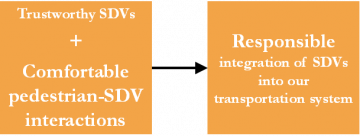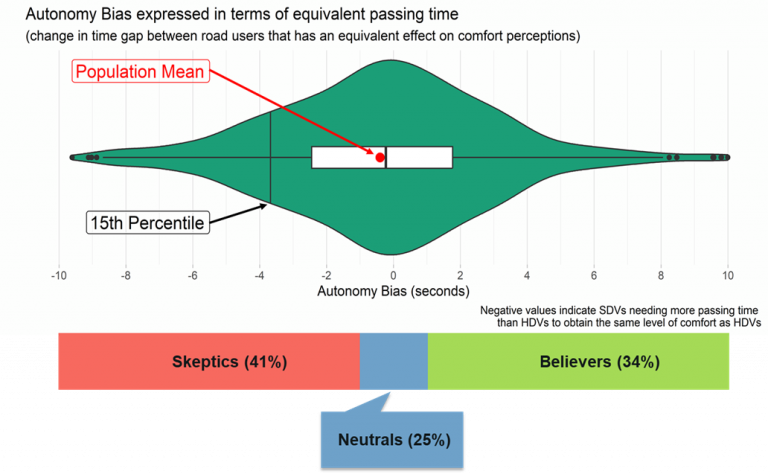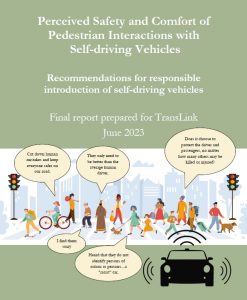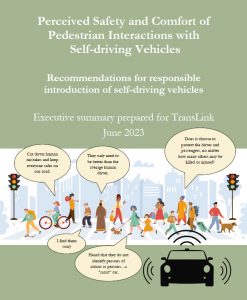Recommendations for responsible introduction of self-driving vehicles
Project Summary
Motivation

Public agencies are promoting active modes of travel such as walking and cycling. In parallel, they are also planning for the introduction of self-driving vehicles (SDVs) into existing transportation systems, in large part because SDVs are expected to improve road safety. But SDVs should be introduced and integrated responsibly – they should support active modes of travel rather than degrade their experience.
Responsible introduction of SDVs has two components: (1) ensuring SDV technology is trustworthy, and (2) the travel experience of active mode users is comfortable, which includes the quality of pedestrian-SDV interactions. While SDVs may differ in a number of ways from HDVs (human-driven vehicles), the fundamental difference is that vehicle control is ceded from a human to a computer. This difference, along with other changes in vehicle operation or appearance, will likely influence perceptions of safety and comfort for active travellers.
Objectives
The goal of this study is to inform strategies for the responsible introduction of SDVs in a way that does not degrade the walking experience. We investigate three main research questions (RQ):
RQ1: Do people perceive pedestrian interactions with SDVs as more or less comfortable and safe than interactions with HDVs, controlling for all other differences (i.e., is there an “Autonomy Bias”)?
RQ2: Does the Autonomy Bias vary systematically within the population (e.g. with age, gender, ethnicity, travel habits, and so on)?
RQ3: Which personal attributes, including Autonomy Bias, determine support for various SDV policies?
Methods

We developed a novel deception-based experiment within a web survey to measure the Autonomy Bias (i.e., examine if people perceive pedestrian-SDV interactions as more or less comfortable and safe than pedestrian-HDV interactions, controlling for all other differences). In the experiment, all 1133 survey participants from British Columbia watched the same 8 video clips of pedestrian-vehicle interactions at crosswalks. We described a random half of the interacting vehicles as SDVs, and the other half as HDVs (all vehicles were in fact HDV). Each participant assessed the comfort and safety of those interactions and we developed statistical models to quantify each participant’s Autonomy Bias.
The unique deception-based experimental design allowed us to isolate the bias effect of vehicle autonomy on comfort and safety perceptions (RQ1), which we report as the additional seconds of passing time that would generate an equivalent effect on perceptions of safety and comfort. To address RQ2, we specified a structural equation model (SEM) with Autonomy Bias as the dependent variable and personal attributes and attitudes (collected from survey participants) as independent variables. To address RQ3, we specified another SEM with SDV policies as the dependent variables and personal attributes, attitudes, and Autonomy Bias as independent variables.
Key Findings
- Both positive and negative Autonomy Biases exist, varying substantially across BC residents, who have a small but significant negative mean bias. More people in the population (41%) are Skeptics (i.e., they have a bias against SDVs), compared to 34% Believers (who have a bias in favour of SDVs); a substantial portion (25%) are Neutrals with no substantial bias (smaller than 1 second equivalent passing time).
- Autonomy Bias varies systematically with gender, tech savviness, and affective response to SDV (level of anxiety or enthusiasm), but not with other socio-demographic factors or travel habits. People who are anxious about SDV technology or are uncomfortable embracing new technology (and cis-men) are more likely to have a bias against SDVs, which would tend to degrade their walking experience.

- Similar to Autonomy Bias, BC residents are close to evenly split on whether they support two general SDV policies: allowing privately-owned or shared SDVs to operate on public roads.
- In contrast, a large majority of BC residents want SDVs to be clearly identified, have a human “driver” present, and be restricted from entering pedestrian-dominated areas such as near schools.

- Even though two SDV-related factors – being enthusiastic about SDVs and having a more positive Autonomy Bias – determine SDV policy support most consistently, socio-demographic factors persist. A few subgroups of the population (including equity-seeking groups) give less policy support; older people are less likely to favour shared SDVs, people of colour and non-cis-men want to restrict SDVs from operating without a “driver”, and people with less auto mobility want to restrict SDVs from going into pedestrian priority areas.
Recommendations
A cautious, tiered approach
- We recommend a cautious, tiered approach to SDV introduction based on:
- the demonstrated potential for SDVs to both positively and negatively impact perceptions of safety and comfort for pedestrians
- the divided support for SDV introduction
- the strong support for SDV restrictions
- The introduction should begin with pilot testing, with specific restrictions, to address the concerns of BC residents.
- The restrictive pilot testing will allow road users to experience and observe interactions with SDVs in more limited and controlled settings.
Guidelines for pilot testing
- To ensure comfort, SDVs should be programmed to operate more conservatively than HDVs around pedestrians. Specifically, SDVs must allow 3.7 seconds additional passing time at crosswalks than typical HDVs to offset the Autonomy Bias of 85% of the population.
- SDVs should be required to have external communication features that, at the least, inform other road users that the motor vehicle they are interacting with is self-driven.
- SDVs should be required to have a person in the driver’s seat to take control of the vehicle in emergencies and provide interacting road users with a familiar human presence with an oversight function.
- SDVs should not be initially tested in pedestrian priority areas such as near schools.
Beyond pilot testing
- Opportunities should be provided to the public to gain knowledge about SDV technology, operations, and performance.
- Familiarity with SDVs from SDV experience (during pilot testing) and gaining knowledge can lead to more enthusiasm, which in turn leads to favourable perceptions of SDVs (i.e., positive Autonomy Bias) and increases support for “pro-SDV” policies.
- Public feedback should be sought through surveys, interviews, and focus groups to evaluate road users’ level of comfort and policy support before, during, and after pilot testing of SDVs.
- If the perceptions of a reasonably large proportion of the public shift toward comfort, then SDV restrictions can be eased accordingly.
Reports
 |
 |
 |
| Final Report (June 2023) | Executive Summary (June 2023) | Visual Summary Slides (June 2023) |
Project Information
Funding
This research was funded by TransLink’s New Mobility Research Grant Program. The views expressed in this report are those of the authors and do not necessarily represent the views of the project funder.
Research team
- Gurdiljot Gill, Graduate Research Assistant, Department of Civil Engineering, University of British Columbia (UBC)
- Dr. Alexander Bigazzi, Principal Investigator and Corresponding Author (alex.bigazzi@ubc.ca), Department of Civil Engineering, UBC
- Dr. Jordi Honey-Rosés, Co-Investigator, Institute of Environmental Science and Technology, Universitat Autònoma de Barcelona, and Institute for Environment, Resources and Sustainability, UBC
- Emily Bardutz, Graduate Research Assistant, School of Community and Regional Planning, University of British Columbia
Acknowledgements
The authors would like to thank the following people for offering valuable direction and advice on this project:
- From UBC: Amir Hassanpour, Elmira Berjisian, and Fajar Ausri
- From TransLink: Graham Cavanagh and Mirtha Gamiz
We would also like to acknowledge the time and valuable input from all the survey participants.